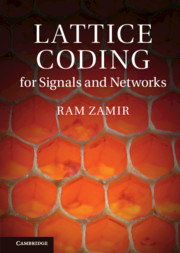 Lattice Coding for Signals and Networks
Lattice Coding for Signals and Networks Book contents
- Frontmatter
- Dedication
- Contents
- Preface
- Acknowledgements
- List of notation
- 1 Introduction
- 2 Lattices
- 3 Figures of merit
- 4 Dithering and estimation
- 5 Entropy-coded quantization
- 6 Infinite constellation for modulation
- 7 Asymptotic goodness
- 8 Nested lattices
- 9 Lattice shaping
- 10 Side-information problems
- 11 Modulo-lattice modulation
- 12 Gaussian networks
- 13 Error exponents
- Appendix
- References
- Index
6 - Infinite constellation for modulation
Published online by Cambridge University Press: 05 August 2014
- Frontmatter
- Dedication
- Contents
- Preface
- Acknowledgements
- List of notation
- 1 Introduction
- 2 Lattices
- 3 Figures of merit
- 4 Dithering and estimation
- 5 Entropy-coded quantization
- 6 Infinite constellation for modulation
- 7 Asymptotic goodness
- 8 Nested lattices
- 9 Lattice shaping
- 10 Side-information problems
- 11 Modulo-lattice modulation
- 12 Gaussian networks
- 13 Error exponents
- Appendix
- References
- Index
Summary
Digital communication is the process of encoding an information source and sending it digitally over a noisy channel. Chapter 5 dealt with the source coding part: digitization of an analog signal using a lattice quantizer. In this chapter we shall consider the channel coding part: translation of digital information into an analog signal via lattice modulation, and detection of the information from a noisy version of the signal with a small probability of error.
In lattice modulation, the lattice points form the signal constellation, or codebook, where each lattice point carries a different message (Sections 1.1 and 3.3). Popular examples are pulse-amplitude modulation (PAM) and quadrature-amplitude modulation (QAM), which correspond to one-dimensional and two-dimensional lattice-like constellations. A general approach to constructing multi-dimensional lattice constellations is by shaping, i.e., by cutting a finite section from a lattice. The most popular shapes are a cube (uncoded constellation), a ball (spherical shaping) or the Voronoi cell of some coarse lattice (Voronoi shaping), as we shall see in Chapter 9.
In this chapter we want to keep the lattice unbounded – just as for the dithered lattice quantizer of Chapter 5. Thus we are faced with a problem: how do we define the transmission power and the coding rate of an infinite constellation?
- Type
- Chapter
- Information
- Lattice Coding for Signals and NetworksA Structured Coding Approach to Quantization, Modulation and Multiuser Information Theory, pp. 110 - 133Publisher: Cambridge University PressPrint publication year: 2014


